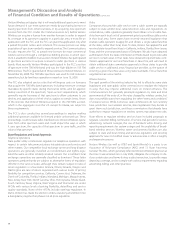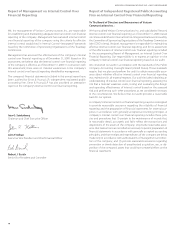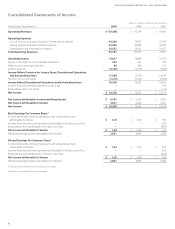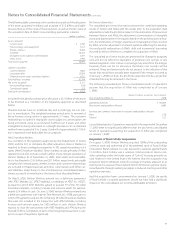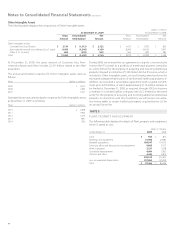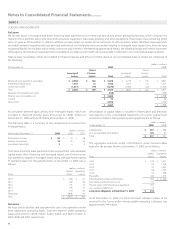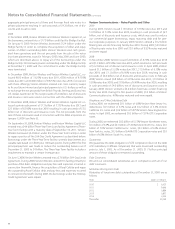Verizon Wireless 2009 Annual Report Download - page 50
Download and view the complete annual report
Please find page 50 of the 2009 Verizon Wireless annual report below. You can navigate through the pages in the report by either clicking on the pages listed below, or by using the keyword search tool below to find specific information within the annual report.Notes to Consolidated Financial Statements continued
48
For information related to the carrying amount of goodwill by segment,
wireless licenses and other intangible assets, as well as the major com-
ponents and average useful lives of our other acquired intangible assets,
see Note 4.
Fair Value Measurements
Fair value of financial and non-financial assets and liabilities is defined
as an exit price, representing the amount that would be received to sell
an asset or paid to transfer a liability in an orderly transaction between
market participants. The three-tier hierarchy for inputs used in measuring
fair value, which prioritizes the inputs used in the methodologies of mea-
suring fair value for assets and liabilities, is as follows:
Level 1 – Quoted prices in active markets for identical assets or liabilities
Level 2 – Observable inputs other than quoted prices in active markets
for identical assets and liabilities
Level 3 – No observable pricing inputs in the market
Financial assets and financial liabilities are classified in their entirety based
on the lowest level of input that is significant to the fair value measure-
ments. Our assessment of the significance of a particular input to the fair
value measurements requires judgment, and may affect the valuation of
the assets and liabilities being measured and their placement within the
fair value hierarchy.
See Note 10 for further details on our fair value measurements.
Income Taxes
Our effective tax rate is based on pre-tax income, statutory tax rates, tax
laws and regulations and tax planning strategies available to us in the
various jurisdictions in which we operate.
Deferred income taxes are provided for temporary differences in the
bases between financial statement and income tax assets and liabilities.
Deferred income taxes are recalculated annually at rates then in effect.
We record valuation allowances to reduce our deferred tax assets to the
amount that is more likely than not to be realized.
We use a two-step approach for recognizing and measuring tax benefits
taken or expected to be taken in a tax return. The first step is recognition:
we determine whether it is more likely than not that a tax position will be
sustained upon examination, including resolution of any related appeals
or litigation processes, based on the technical merits of the position. In
evaluating whether a tax position has met the more-likely-than-not rec-
ognition threshold, we presume that the position will be examined by
the appropriate taxing authority that has full knowledge of all relevant
information. The second step is measurement: a tax position that meets
the more-likely-than-not recognition threshold is measured to determine
the amount of benefit to recognize in the financial statements. The tax
position is measured at the largest amount of benefit that is greater than
50 percent likely of being realized upon ultimate settlement. Differences
between tax positions taken in a tax return and amounts recognized in
the financial statements will generally result in one or more of the fol-
lowing: an increase in a liability for income taxes payable, a reduction of
an income tax refund receivable, a reduction in a deferred tax asset, or an
increase in a deferred tax liability.
The accounting standard relating to income taxes generated by lever-
aged lease transactions requires that changes in the projected timing of
income tax cash flows generated by a leveraged lease transaction be rec-
ognized as a gain or loss in the year in which the change occurs.
Significant management judgment is required in evaluating our tax posi-
tions and in determining our effective tax rate.
Goodwill and Other Intangible Assets
Goodwill
Goodwill is the excess of the acquisition cost of businesses over the
fair value of the identifiable net assets acquired. Impairment testing
for goodwill is performed annually in the fourth fiscal quarter or more
frequently if indications of potential impairment exist. The impairment
test for goodwill uses a two-step approach, which is performed at the
reporting unit level. We have determined that in our case, the reporting
units are our operating segments since that is the lowest level at which
discrete, reliable financial and cash flow information is regularly reviewed
by our chief operating decision maker. Step one compares the fair value
of the reporting unit (calculated using a market approach and/or a dis-
counted cash flow method) to its carrying value. If the carrying value
exceeds the fair value, there is a potential impairment and step two must
be performed. Step two compares the carrying value of the reporting
unit’s goodwill to its implied fair value (i.e., fair value of reporting unit
less the fair value of the unit’s assets and liabilities, including identifiable
intangible assets). If the implied fair value of goodwill is less than the car-
rying amount of goodwill, an impairment is recognized.
Intangible Assets Not Subject to Amortization
A significant portion of our intangible assets are wireless licenses that
provide our wireless operations with the exclusive right to utilize des-
ignated radio frequency spectrum to provide cellular communication
services. While licenses are issued for only a fixed time, generally ten years,
such licenses are subject to renewal by the Federal Communications
Commission (FCC). Renewals of licenses have occurred routinely and at
nominal cost. Moreover, we have determined that there are currently
no legal, regulatory, contractual, competitive, economic or other factors
that limit the useful life of our wireless licenses. As a result, we treat the
wireless licenses as an indefinite-lived intangible asset. We reevaluate the
useful life determination for wireless licenses each reporting period to
determine whether events and circumstances continue to support an
indefinite useful life.
We test our wireless licenses for potential impairment annually or more
frequently if indications of impairment exist. We evaluate our licenses
on an aggregate basis using a direct income-based value approach. The
direct value approach estimates fair value using a discounted cash flow
analysis to estimate what a marketplace participant would be willing to
pay to purchase the aggregated wireless licenses as of the valuation date.
If the fair value of the aggregated wireless licenses is less than the aggre-
gated carrying amount of the licenses, an impairment is recognized.
Interest expense incurred while qualifying activities to develop wireless
licenses for service are underway is capitalized as part of wireless licenses.
The capitalization period ends when the development is completed.
Intangible Assets Subject to Amortization
Our intangible assets that do not have indefinite lives (primarily customer
lists and non-network internal-use software) are amortized over their
useful lives and reviewed for impairment whenever events or changes
in circumstances indicate that the carrying amount of the asset may
not be recoverable. If any indications were present, we would test for
recoverability by comparing the carrying amount of the asset to the net
undiscounted cash flows expected to be generated from the asset. If
those net undiscounted cash flows do not exceed the carrying amount
(i.e., the asset is not recoverable), we would perform the next step, which
is to determine the fair value of the asset and record an impairment, if
any. We reevaluate the useful life determinations for these intangible
assets each reporting period to determine whether events and circum-
stances warrant a revision in their remaining useful lives.


